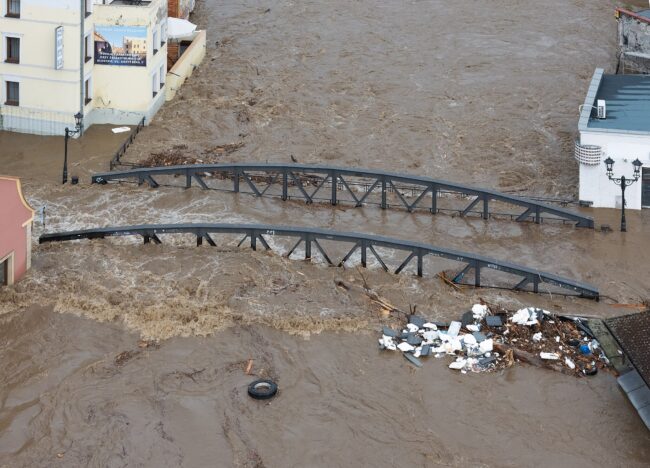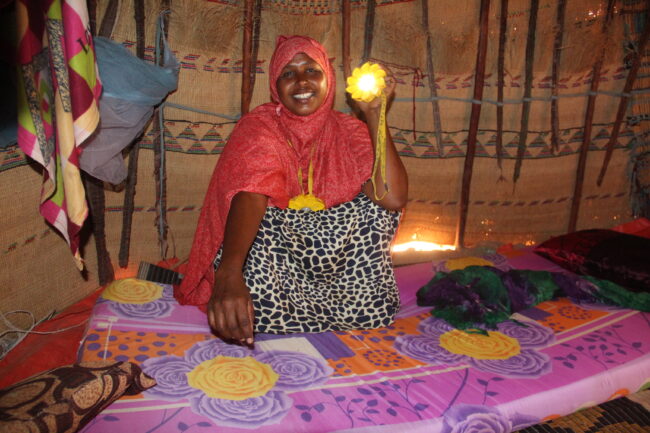
2024 was the hottest year on record. Around the world, 151 unprecedented extreme weather events devastated countries around the planet, including heat waves in Japan and Iran, floods in Italy, Pakistan, Poland and Brazil, and typhoons in Vietnam and the Philippines. Massive sums of money are needed to mitigate these and other climate disasters and to prepare for what’s on the horizon.
Climate finance is key: to help developing countries adapt to climate impacts and reduce their carbon emissions, the public and private sectors and other financial institutions must work together to harness funds needed for such an enormous undertaking.
To address this need, the Columbia Climate School has introduced a new Master of Science in Climate Finance program, in partnership with the Columbia Business School, to begin fall 2025. Led by Lisa Sachs, director of the Columbia Center on Sustainable Investment, it is a one-year professional degree program for both early-career and experienced professionals. The program will enable students to understand the science and impacts of climate change, assess its risks and opportunities, understand the financing imperatives, and consider implications for both policy and financial institutions. Because it’s estimated that about $5 to $10 trillion annually will be needed to decarbonize the global economy, in addition to the mounting costs of adaptation, the climate finance sector will be increasingly important in years to come.
The good news? There’s enough money to solve the crisis. “With around $30 trillion in global savings annually, there is more than enough capital to fund the global transition,” said Sachs, an expert on how laws, policies and business shape global investment flows.
And the bad? Finance is flowing in the wrong direction—concentrated in developed markets, inaccessible to much of the Global South—underfunding adaptation and innovation and still backing high-carbon investments. “The amount of financial capital—whether it’s from multilaterals, from the countries’ own governments, or from the private sector—flowing into climate mitigation or adaptation in the vast majority of developing countries is very low,” said Bruce Usher, co-director of the Tamer Center for Social Enterprise at the Columbia Business School. Developing countries’ governments “have limited resources, the World Bank and other multilateral institutions are just not that large, and the private sector finds it very challenging to invest in those countries,” he said.
A moral imperative
Why should wealthy countries pay to fix other countries’ problems? Many stakeholders feel the countries that largely engendered the climate crisis should assume the greatest responsibility for addressing it. Developing countries have contributed far less to climate change than have developed countries, yet they are often the most vulnerable to its impacts, and they tend to be more dependent on the natural world for their livelihoods. According to the U.N., half the world population lives in a climate “danger zone,” where they are 15 times more likely to die from climate impacts than people in wealthier countries.
But developing nations need trillions of dollars each year until 2050 to achieve their adaptation and mitigation goals, according to the Independent High-Level Expert Group on Climate Finance. At COP 29, last year’s U.N. climate summit, wealthy countries committed to mobilize $300 billion annually by 2035, with a broader aspiration to mobilize $1.3 trillion per year of private capital. The pledges, however, are voluntary and not legally binding, and no framework was agreed on how to mobilize the private capital.
“The devastating consequences of not solving this problem that we have created, and that we know how to solve, seems to me like the most profound moral failure,” said Sachs. “What makes it worse is that those who contributed the most [to climate change] will certainly be impacted, but not as immediately or completely as countries who face livelihoods wiped out, economic upheaval or submerged shorelines.”
Follow the money
Most climate finance comes from domestic public budgets and private investment, while multilateral development banks (international financial institutions set up by two or more countries), bilateral donors and vertical funds like the Green Climate Fund (GCF), contribute a smaller share that can jump-start additional funding—often in the form of financial assistance by governments to de-risk and leverage larger flows.

The GCF distributes its monies to local development banks and organizations to finance adaptation and mitigation projects in developing countries. The fund initially raised $10 billion in pledges. Total pledges to the GCF for its 2024-2027 programming cycle now stand at USD $13.6 billion from 34 countries and one region.
The debt debacle
Under the Paris Agreement, half of climate finance funds are to be spent on adaptation and half on mitigation. Yet over 90% of climate finance is currently directed toward mitigation, and most of it in the form of loans—loans that are very expensive for developing countries to repay.
“Developing countries are locked into a vicious cycle because the credit rating agencies rate them as risky and sub-investment grade, largely as a result of their poverty,” said Sachs. “The terms of the borrowing are incredibly high, with short maturities, increasing the risk of defaults, which exacerbates their risk profile.” It leads to a situation where 60% of less-developed countries are in debt, with some spending five times more on their debt each year than on climate adaptation. One analysis found that in 2021, 59 countries paid debt service of $33 billion while only receiving $20 billion in climate finance.
Developing countries need patient, long-term financing to build critical infrastructure, said Sachs. Climate projects may take many years to recoup their costs. “A solar project is a very low-risk investment and attractive to investors as long as you’re comfortable making a 20- to 30-year commitment,” said Usher. “But in many developing economies, the cost of capital for 20 or 30 years is very high. There is no capital willing to go that long because of risks specific to those countries.” For example, a developing country’s currency might be unstable and rapidly lose value, so an investor paid back in local currency that has devalued would end up losing money. Developing countries shoulder the burden of that currency risk.
Investing in adaptation vs. mitigation strategies
While the most common mitigation strategies include investing in renewable energy, carbon capture and storage, electrification of transportation, making buildings more energy efficient, and improving water management, adaptation projects aim to make infrastructure resilient to climate impacts, develop agricultural practices that are efficient and sustainable, aid transition to more sustainable livelihoods, and restore biodiversity.
Adaptation efforts can also lower the cost of damages from climate impacts. For example, $1 billion invested to forestall coastal flooding could reduce damages by $14 billion, according to the UNEP Adaptation Gap Report 2023. But less money is directed towards adaptation and loss and damages than to mitigation because they have often no clear returns on investments. “There’s little case for the private sector to fund projects that are not likely to have a return,” said Sachs.
To help vulnerable countries deal with climate impacts that cannot be adapted to or avoided, a Loss and Damage Fund was established during COP27. As of March 2025, $765 million has been pledged to the fund by 26 countries and the EU. (No country is currently obligated to pay into the fund.) The U.S. initially pledged $17.5 million for the fund, but the Trump administration has withdrawn the nation from the fund.

For example, in Ethiopia, the World Bank is buying the emissions reductions from the distribution of 2.8 million solar lanterns and over 200,000 home solar systems to replace kerosene lamps and diesel generators. The switch cuts nearly 24,000 metric tons of CO2 each year.
The status of climate finance
While funds for adaptation increased from 2021 to 2022 , the gap between the estimated amount that will be needed for adaptation ($215 to $387 billion) this decade and the amount of actual money that has come in (as of 2022) of $28 billion, is still large. The longer the gap persists, the more developing countries stand to suffer losses and damages from climate change. The financing gap also erodes trust between developing countries and wealthier ones. An Oxfam expert noted that when developing countries see rich countries not fulfilling their finance pledges, they begin to doubt the promises they make on other issues at climate talks.
Sachs believes that a complete overhaul of the climate financial system is necessary. The cost of capital for investing in developing countries needs to come down, and the ratings of developing countries need to be improved, she said. And since private capital is critical for climate finance, development finance institutions should more effectively catalyze private investment by providing enhanced credit to relevant projects and sovereign finance. “If they can de-risk projects or provide guarantees or otherwise further leverage private finance, then private finance can become more affordable,” said Sachs.
“It’s really important that the World Bank and other multilateral institutions, step up their financing in developing countries,” said Usher. While the World Bank provided a record amount of climate finance in 2024—$42 billion—the actual need is in the trillions of dollars. For development finance institutions to be able to lend more, however, they must get more paid-in capital from the rich countries. But rich countries have been reluctant to capitalize the development finance institutions. Development finance institutions could potentially lend more even without additional paid-in equity or take on increased risk with the capital they have. “They are hesitant, however, because they don’t want to jeopardize their Triple A credit rating,” said Sachs. “Both more capital and more leverage should be part of the solution.”
Countries and regions should have master plans—roadmaps that lay out what the energy transformation is going to look like for them. “Each region or country needs to identify what the mix of solar and wind and geothermal and hydro is,” said Sachs. “Where should these be sited? What infrastructure is needed for transmission and distribution?” Beyond the technical scenario, the master plan should also identify what investments are needed and which are suitable for public or private finance.
Some master plans are already in the works. The Council of Engineers for the Energy Transition, an advisory council to the U.N. Secretary-General, is developing technological roadmaps in each of the U.N. regions, while Sachs and the Columbia Center on Sustainable Investment are working on the financial side. They are studying the challenges, financing institutions, funds and financial possibilities in each of the regions.
As for the future of climate finance, Usher said, “It’s incredibly important that the capital flows increase since we really can’t reduce emissions in developing countries because they are not very polluting. And they can’t continue to grow their economies and raise prosperity for their citizens without foreign investment. The capital is there—the large pools of capital exist in the private sector. But that foreign investment is not available without some additional risk mitigation measures. And the only way that’s going to happen is with the public sector and the private sector essentially working together.”
Learn more about the M.S. in Climate Finance, a professional degree program offered by the Columbia Climate School in close collaboration with the Columbia Business School, here.




No Comments
Leave a comment Cancel